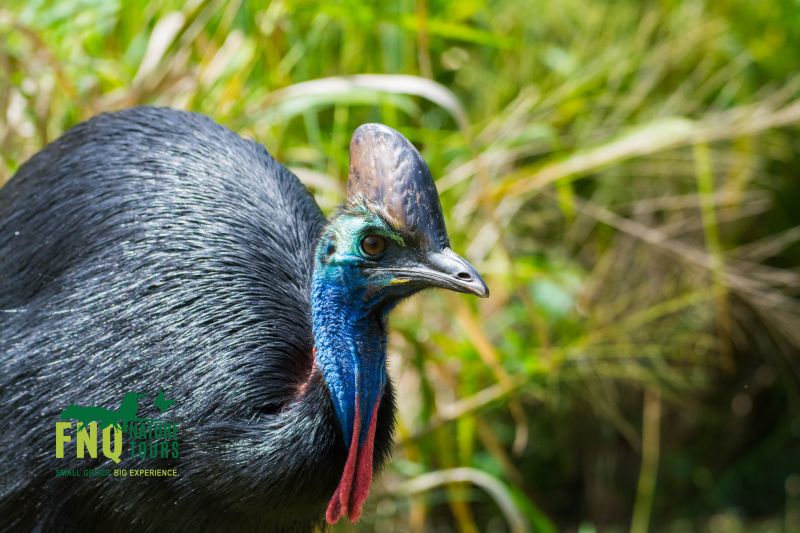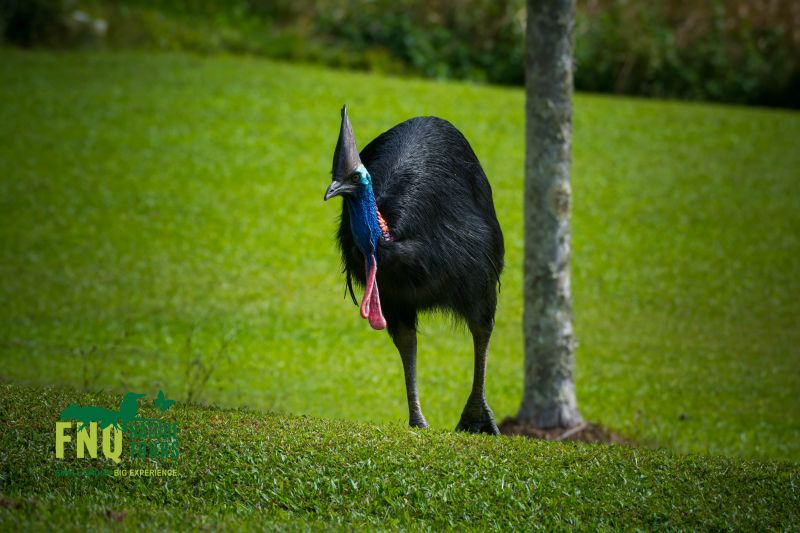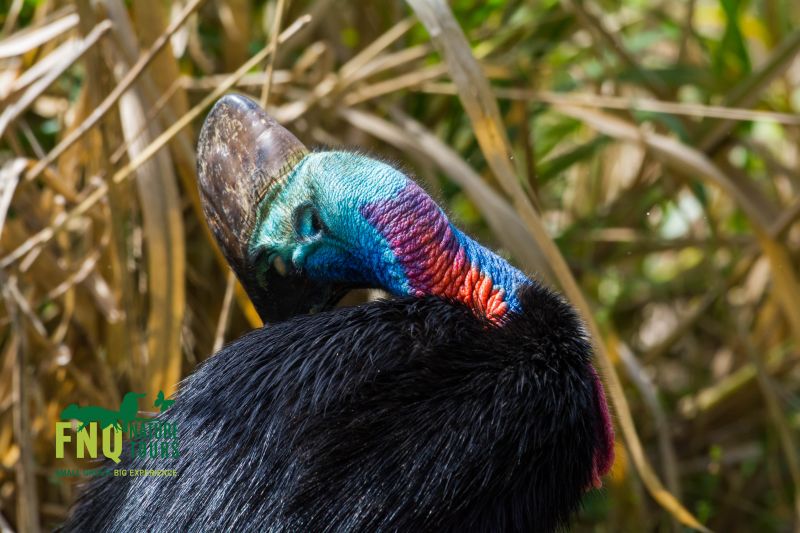The purpose of the Southern Cassowary’s distinctive casque (helmet), which is unique to every individual, is unknown, but recent research suggests that it may help cassowaries to feel the low vibrating sound made by other cassowaries over long distances. This unusual sense, called infrasound, was used by some dinosaurs, and is also shared by a few modern animals, including cassowaries and elephants.Another striking feature of the cassowary is its long, glossy black feathers, which are coarse and hair-like. Cassowary feathers differ from other birds in that they have a quill that splits in two and lack the barbules that normally hold birds’ feathers together.
As you may have noticed from the footage, these photos were taken from a relatively close distance which wasn’t planned and should be avoided during Wild Cassowary Interactions. The Southern Cassowary is a predatory animal and should be respected as such. In this scenario I was fortunate the male Cassowary paid absolutely no attention to me and wasn’t threatened by my presence. In the Etty Bay region, it is quite common for people to be approached by these beautiful birds, always remember not to feed them or get too close!
After enjoying the male resting on the edge of a local sugar cane field, he started walking in my direction, but in a very relaxed manner so i felt completely comfortable. Not long after he moved on, the female came from the direction he went. She was also quite unfazed and so incredibly beautiful to photograph.

Southern Cassowaries
The colorful cassowary is one of the most recognizable icons of the Wet Tropics. This striking bird with its brilliant blue and purple head and neck, red wattles, and amber eyes, appears extensively on promotional brochures and souvenirs throughout the region. However, it is an endangered species and its future is uncertain.
The Reptile Bird Connection
In evolutionary terms, the flightless birds (or ratites) were some of the earliest types of birds to develop. The Southern Cassowary, Emu, Rhea, Kiwi and strich are still around today, but others, like the moas of New Zealand and the elephant bird of Madagascar are now extinct.
Cassowaries evolved in a region of the supercontinent, Gondwana, that later broke apart and became Northern Australia, Papua New Guinea and some of the eastern island groups of Indonesia. Three species of cassowaries are found in Papua New Guinea but only the southern cassowary (also known as the double-wattled cassowary) lives in Australia.
Two separate populations of cassowary are found here – one in the Wet Tropics between Mt Halifax/Paluma and Cooktown, and the other in the Shelburne Bay area and eastern Cape York Peninsula (McIlwraith and Iron Ranges from Temple Bay to Massey River, and possibly into Princess Charlotte Bay).
The Secret Lives of Southern Cassowaries
Cassowaries are solitary animals. Once a cassowary has established its home range, it moves regularly through that range. Home territories average around 0.52km² to 2.35km², but can be much larger – for example in the rainforests of the Atherton Tablelands or in the Daintree, where some birds have been observed to have a home range of roughly 7 square km. This increased range leads to fewer interactions between birds. Home ranges are not necessarily clearly defined and defended territories, they can overlap, and the shape and area of the range changes depending on the availability of food and the breeding cycle. Females tend to have overlapping ranges with several males.
Cassowaries are most often found in rainforest, but also use woodlands, melaleuca swamps, mangroves and even beaches, both as food sources and as connecting habitat. Cassowaries in coastal areas, such as around Mission Beach, seem to prefer a mix of these environments. Cassowaries have turned the tables on what is mostly a maternal social structure in the animal world! After mating, females will lay a clutch of eggs, and then seek other males with which to mate. For each male that she finds, she will provide a clutch of eggs (usually 3 to 5) for him to nurture.
The males incubate the eggs, and raise the chicks, caring for them until they are able to look after themselves. Somewhere between 8-18 months of age, fathers will banish the sub-adults from their home range. The young birds wander off to find their own patch of habitat, and start learning their way around. This is a vulnerable time for young cassowaries. Dogs can easily chase them and kill them, they are more likely to wander onto roads and get hit by vehicles, an adult cassowary already resident in an area might attack them, and they may not be able to find sufficient food in a new and unfamiliar area.
Cassowaries are very difficult to study because they lead solitary lives and live in dense tropical rainforest and remote and rugged terrain, so there is still much we don’t know about them. It is difficult to accurately assess cassowary numbers, but best estimates suggest the total Australian population of the southern cassowary is about 4,000 adults.

Why are cassowaries so important? The cassowary plays an important role as rainforest gardener!
The Wet Tropics rainforest would be a very different place without cassowaries. Cassowaries have been recorded eating over 238 species of plants, and they play an important role in maintaining the diversity of the rainforest. Cassowaries prefer fallen fruit to other food, but will also eat small vertebrates (such as snails and frogs, small birds and eggs), invertebrates, fungi, carrion and plants. After cyclones, when fruit is scarce, these may become an important part of their diet.
Cassowaries are one of only a few species that can disperse large rainforest fruits and are the only long distance dispersal agent for large seeded fruits. These huge birds are the only animals capable of distributing the seeds of more than 70 species of trees whose fruit is too large for any other forest dwelling animal to eat and relocate. In other tropical forests around the world, there are a wide range of animals which fulfill this role, but without cassowaries, rainforest in the Wet Tropics would gradually change and become less diverse.

Cassowaries are also capable of eating fruits and seeds that would be toxic to other species. The cassowary’s digestive system (they have an unusual combination of stomach enzymes), short intestines, and highly active liver, may help to protect them from absorbing a harmful level of toxins from some of the fruits they eat.
Other animals such as white-tailed rats may help distribute smaller seeds but more often than not, they damage the seed rather than dispersing it intact. Cassowaries swallow fruit whole, digesting the pulp, and passing the seeds unharmed in large piles of dung, distributing them over large areas throughout the rainforest. A ready-made fertiliser, the dung helps many kinds of seed to grow. Other animals sometimes feed on the seeds in cassowary droppings, helping to distribute them further.
Their role in helping to maintain the diversity of the rainforest is why cassowaries are considered a ‘keystone’ species. Protecting cassowary habitat and food plants benefits many other rainforest plants and animals.
Threats to Southern Cassowaries
Sadly, the Wet Tropics population of the Southern Cassowary is still declining. The Southern Cassowary is listed as Endangered by the Queensland and Australian Governments, and Vulnerable by the IUCN Red List. Land clearing, particularly in the coastal lowlands and Atherton Tablelands, has significantly reduced cassowary habitat over the last century. Although the rate of habitat loss has slowed now, the population is still threatened by the impacts of fragmentation and other ongoing issues, such as:
- continued loss of habitat through clearing for residential settlement and agricultural expansion
- fragmented habitat (especially from roads and subdivisions)
- vehicle traffic (road kills are the number one cause of adult cassowary deaths)
- dogs (which are especially aggressive to chicks and juveniles)
- feral pigs (impact on their habitat)
- cyclones are a natural part of the Wet Tropics ecosystem, but combined with the other threats mentioned above, can lead to an increase in the death of cassowaries.
One of the saddest, but most easily preventable, threats to cassowaries is the perceived kindness of people who enjoy feeding these impressive birds. Once a cassowary starts to associate people with food, and begins appearing ‘tame’ and approaching humans, or wandering through residential suburbs its chance of being killed by cars or dogs (particularly dogs bred for hunting) increases dramatically.
Adult birds, particularly males with chicks, or if they are used to being fed may also become more aggressive around people. In rare cases, it may be necessary to relocate a problem bird, which is upsetting for both the cassowary and the local community. Feeding native animals can leave to changes in health and behaviour that aren’t immediately obvious. The best way to avoid this is to be cass-o-wary and not feed them.
After cyclones, when food becomes scarce, feeding stations may be set up by the Queensland Parks & Wildlife Service to help supplement cassowaries’ diets. These are usually placed in the forest to draw cassowaries away from the risks posed by humans, dogs and traffic.

There are three main areas in the Wet Tropics that are ‘hot spots’ for cassowaries:
- the Daintree area which has the problem of roads cutting through the bird’s home ranges;
- the Kuranda and Atherton Tableland area which has the problems of habitat loss, fragmentation by roads and marauding dogs;
- the Mission Beach area which has suffered extensive habitat loss to the degree that the birds have been squeezed into unnaturally small home ranges. They are forced to seek food from plantation sources and this closeness to human settlements brings them into more frequent contact with dogs. As they try to move around the remaining patches of habitat between the beach and the sloping hinterland behind it, they are commonly run over by cars.
Southern Cassowary Conservation
Due to its iconic status and ecological significance, the Wet Tropics Management Authority (Wet Tropics) takes a keen interest in cassowary conservation, providing advice to local government and state infrastructure agencies to reduce the impacts of development on cassowaries, and helping to establish and support the Cassowary Recovery Team. You can learn more about Wet Tropics involvement in cassowary conservation here.
The Cassowary Recovery Team website also acts as a central resource for anyone interested in cassowary conservation in Australia. The site incorporates information about southern cassowaries, where to see them, how to report sightings, educational resources, meeting agendas, cassowary news, and how to be cass-o-wary and support conservation efforts.
For more information on how you can spot Southern Cassowaries on tour with FNQ Nature Tours, please click here.

